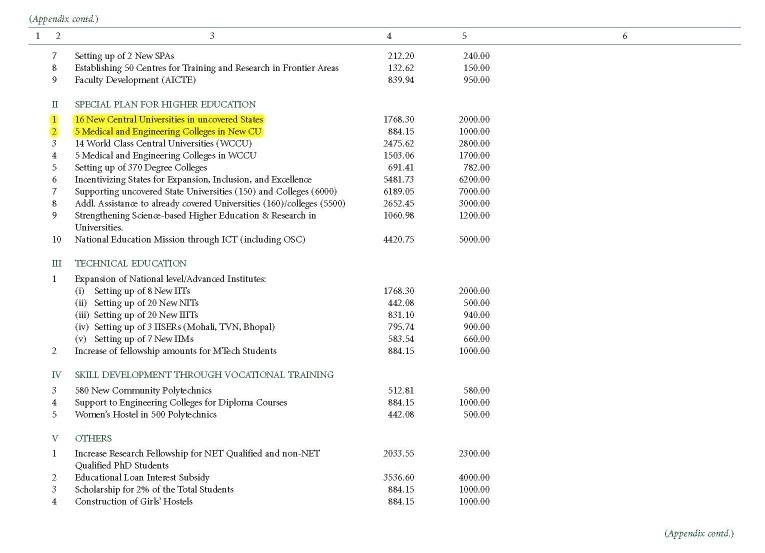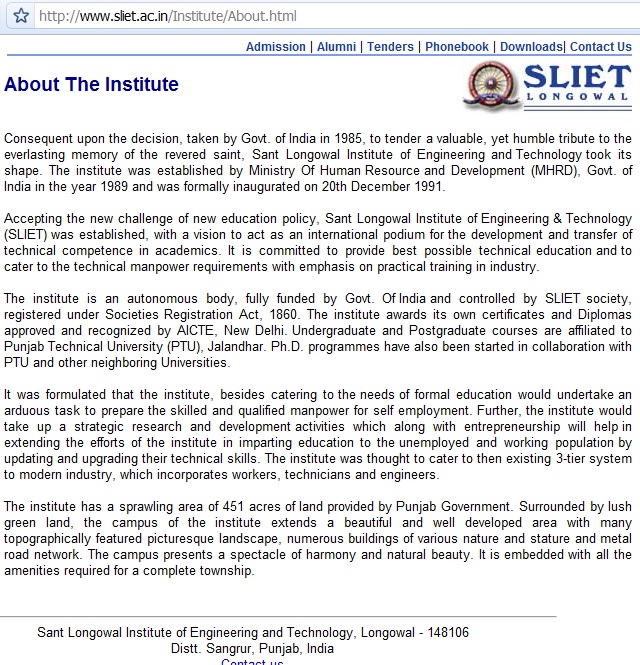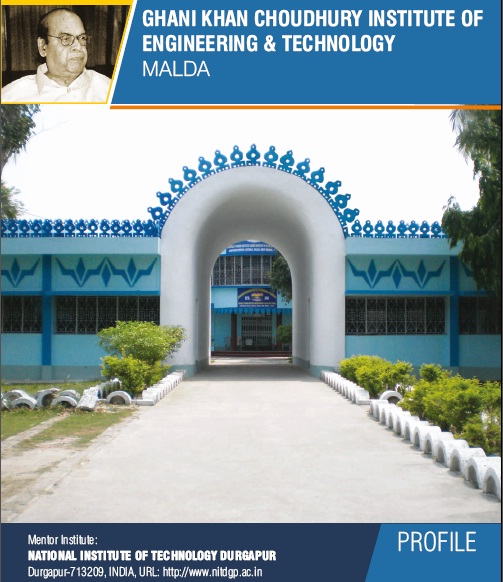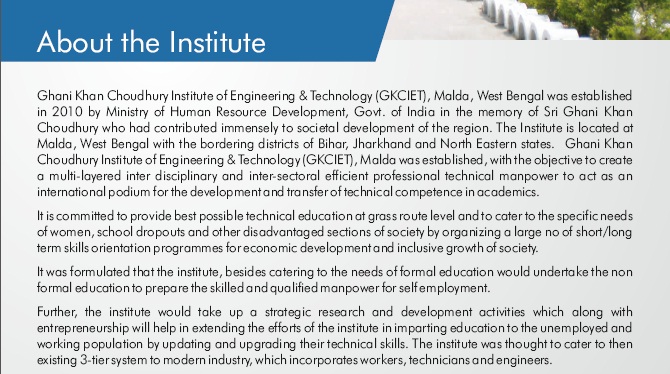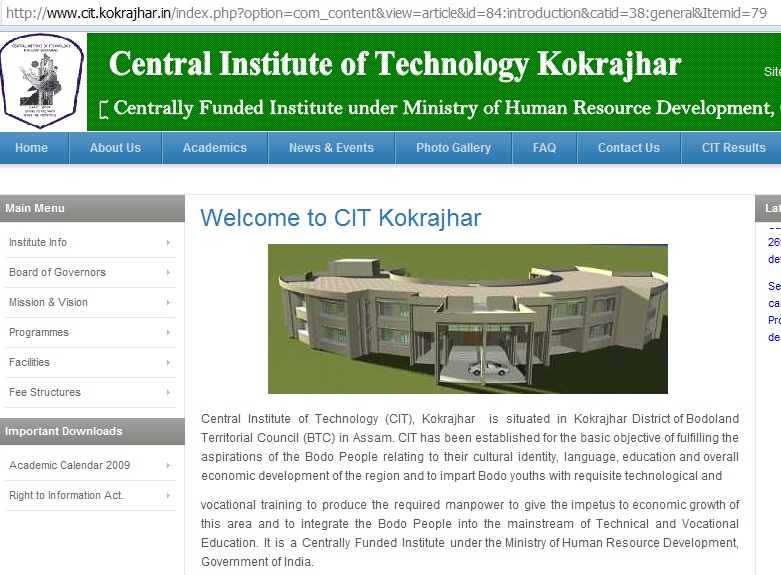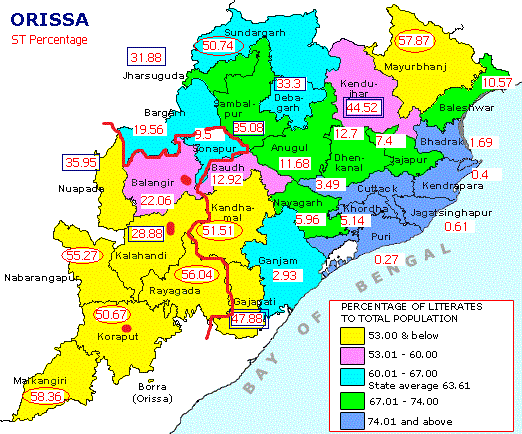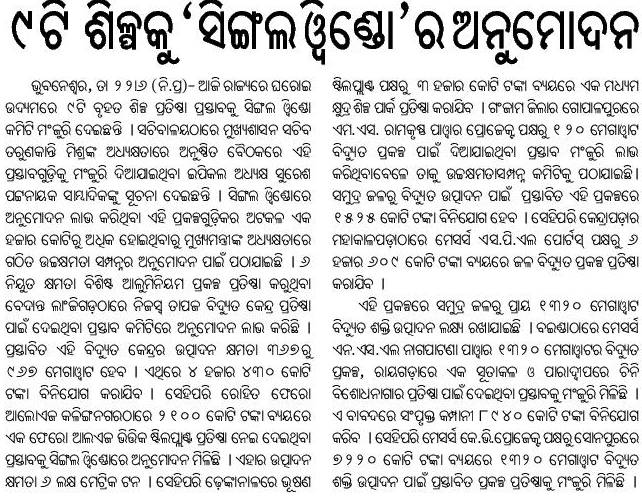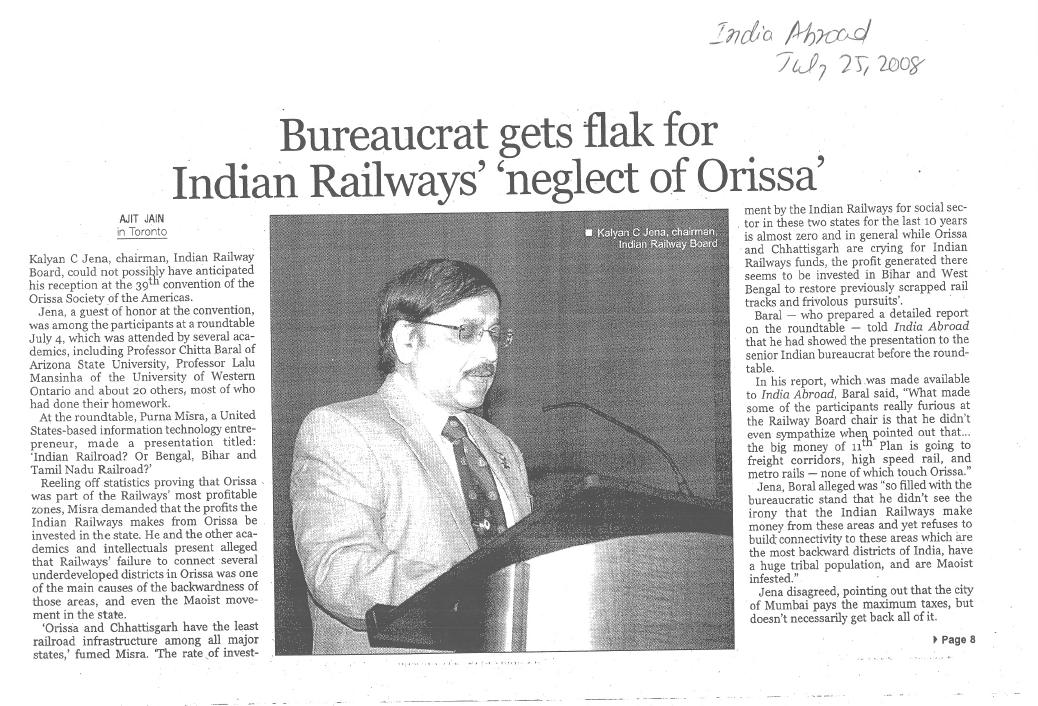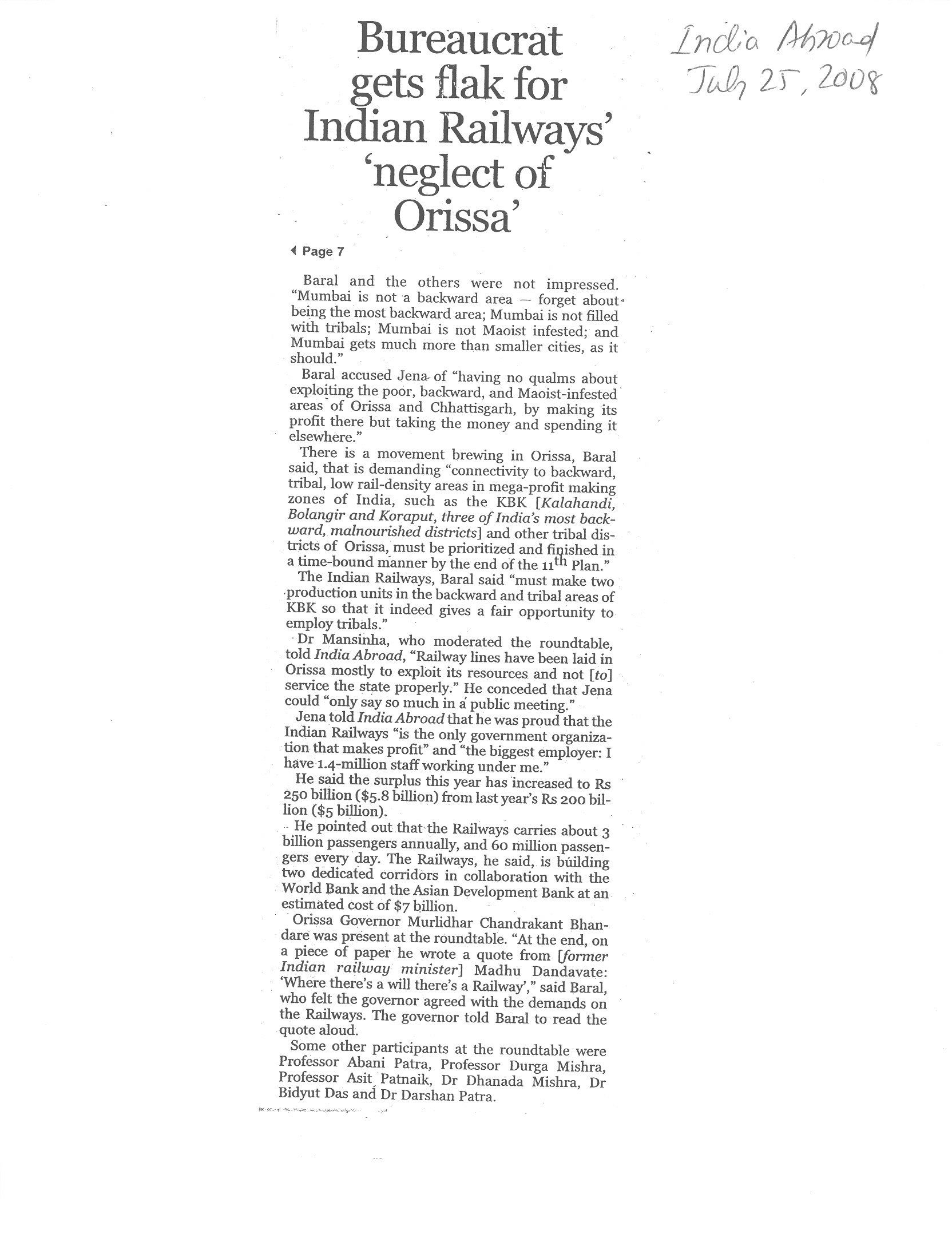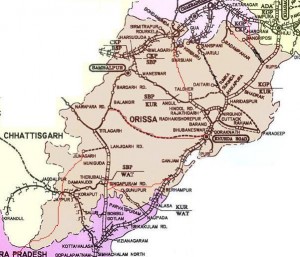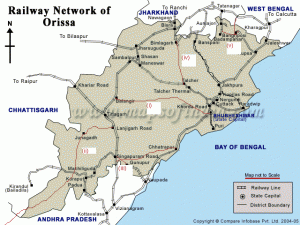(1) ECOR GM Shri Surendra Singh Khurana in his Independence Day address (available at http://eastcoastrailway.gov.in/custom/press_release/index.php) while talking about ECOR, said:
“With only 4% of the track of Indian Railways, we cater for about 12% of total loading of Indian railway and about 7% of total earning of IR.”
(2) From http://finance.groups.yahoo.com/group/irfca/messages
For the 2003-2004 and 2004-05 the working expense as part of gross earnings of the ECOR zone is the second best at 66.64% and 61.75% respectively.
- The profit making zones in those years were
- South east central (62.8% and 56.1%),
- ECOR (66.64% and 61.75%),
- North central (76.33% and 66.71%),
- Central (80.29% and 82.48%),
- South eastern (81.24% and 83.51%),
- South Central (85.72% and 83.62%),
- West Central (80.99% and 84.08%),
- South Western (91.35% and 86.15%),
- Western (93.21% and 90.85%),
- Northern (91.08% and 92.89%) and
- East Central (93.65% and 98.9%).
- The loss making zones were:
- metro Kolkata (247% and 264.38%),
- North Eastern (151.93% and 160.88%),
- Northeast Frontier (147.98% and 159.45%),
- Eastern (161.3% and 152.84%),
- Southern (118.55% and 120.79%) and
- North Western ( 106.26% and 104.98%).
(3) Based on (1) and (2) above ECOR probably makes about 10% of Indian Railways profit.
(4) The above raises the following questions:
Why does not ECOR have the track length commensurate with the earnings it makes?
Why are no serious efforts being made to correct this; especially with many planned lines being given only minimal annual budgets which in many cases are less than the annual inflation.
(5) (Using the data in
In terms of rail density: the average rail density (2004-05) for India is 19.13; the rail density is highest in Delhi (138.2) followed by West Bengal (43.4), Punjab (41.6), Haryana (36.1), Bihar (35.9), Uttar Pradesh (35.8), etc. while Chhatisgarh (8.6) and Orissa (14.6) are among the states with low rail densities.
(6) The data from (1-3) and (5) show that while Indian Railways is making a lot of revenue and profit from ECOR (big part of which is in Orissa) and also SER (part of which is in Orissa), both ECOR and Orissa have been grossly neglected. This is true about the past; what about the future?
Mr V. N. Mathur, Member (Traffic) of the Railway Board is reported to have said:
“We’ve submitted to the Planning Commission a Rs 251,000-crore proposal for implementation by the end of the Eleventh Plan. We’ve indicated mobilisation of Rs 90,000 crore from within and 29 per cent of the projected estimate by way of market borrowing. For the balance, we may have to approach the government for support. But then nothing has yet been finalised.”
(8) Many expensive and highflying plans by Indian Railways for the 11th plan, but most bypass Orissa and ECOR.
(8A) Freight Corridor: Various news reports suggest that the 11th plan (next 5-7 years) will take up the western and eastern corridors.
http://www.indianexpress.com/story/9030.html
Western Corridor: 1,483-km Delhi-Mumbai route
Eastern Corridor: 1,280-km Delhi-Kolkata route
http://www.hindu.com/2006/09/17/stories/2006091708640400.htm reports that the “Chennai-Kolkata and Chennai-Mumbai corridors will be included in the second phase of the Dedicated Freight Corridor Project.”
(8B) High Speed Corridors:
“Delhi-Chandigarh-Amritsar, Mumbai-Baroda-Ahmedabad, Chennai-Bangalore-Coimbatore and Howrah-Asansol-Patna — were announced in the current rail budget.”
(8C) Metro Rails and rapid transit systems: From http://en.wikipedia.org/wiki/Transportation_in_India#Metro and
http://en.wikipedia.org/wiki/Bangalore_Metro
The following are the existing or under construction/expansion metro rail projects.
- Delhi Metro
- Hyderabad Metro
- Kolkata Metro
- Kolkata Suburban Railway
- Lucknow MEMU
- Chennai Metro
- Mumbai Suburban Railway
- Bangalore Metro
- Mumbai Metro •
- Thane Metro
- In planning:
- Ahmedabad Metro
- Kochi Metro
- Goa
- Pune
(9) In essence revenue and profit generated in ECOR is being ploughed into other parts of India, which by itself is not wrong as Orissa is a part of India, but lets analyze who are the losers: the adivasi and backward areas of Orissa (and hence of India) who are backward partly because lack of proper connectivity, and this neglect continues to keep them backward and prevents them from catching up.
Am I making this up?
No, here are the data and following it is what planning commission teams have themselves said.
(10) The tribal population percentage of the KBK districts are as follows:
Malkangiri 58.36% (+19.96% SC), Rayagada 56.04% (+14.28% SC), Nabarangpur 55.27% (+15.09% SC), Koraput 50.67% (+13.41% SC), Nuapada 35.95% (+13.09% SC), Kalahandi 28.88% (+17.01% SC), Sonepur 22.11% (+9.5% SC), Balangir 22.06% (+15.39% SC). Two adjacent districts also have high tribal population. They are Kandhamala 51.51% (+18.21% SC) and Gajapati 47.88% (+8.77% SC). Tirbal percentage of Mayurbhanj is 57.87% and Sundergarh is 50.74%.
(11) The literacy rates in the KBK districts are abysmally low. Malkangiri 31.26%, Nabarangpur 34.26%, Rayagada 35.61%, Koraput 36.2%, Nuapada 42.29%, Kalahandi 46.2%, Balangir 54.93%, Sonepur 64.07%. Two adjacent districts also have low literacy: Gajapati 41.73% and Kandhamala 52.95%. The state average is 63.1%.
(12) Population below the poverty line in southern Orissa (of which KBK is a part) is reported to be 89.17% of the people according to the 1999-2000 NSS data and 72% of the families according to the 1997 census.
(13) From http://www.mainstreamweekly.net/article174.html
Table 1 provides State level data on poverty ratios during 2004-05. The lowest poverty ratio was 5.4 per cent for Jammu and Kashmir and highest poverty ratio was for Orissa (46.4 per cent). States with poverty ratio of less than 15 per cent were Jammu & Kashmir, Punjab, Haryana, Himachal Pradesh, Delhi and Andhra Pradesh. As against them, States with poverty ratio above 30 per cent were Maharashtra, Uttar Pradesh, Bihar, Jharkhand, Madhya Pradesh, Chattisgarh, Uttarakhand and Orissa.
|
Table 1: Number and Percentage of Population Below Poverty Line (2004-05) based on URP Consumption
|
|
State
|
% of Persons
|
No. of persons (in lakhs)
|
% of Persons
|
No. of Persons (in lakhs)
|
% of persons
|
No. of persons(in lakhs)
|
|
S.No.
|
(1)
|
(2)
|
(3)
|
(4)
|
(5)
|
(6)
|
|
1 Jammu & Kashmir
|
4.6
|
3.7
|
7.9
|
2.2
|
5.4
|
5.9
|
|
2 Punjab
|
9.1
|
15.1
|
7.1
|
6.5
|
8.4
|
21.6
|
|
3 Himachal Pradesh
|
10.7
|
6.1
|
3.4
|
0.2
|
10.0
|
6.4
|
|
4 Goa
|
5.4
|
0.4
|
21.3
|
1.6
|
13.8
|
2.0
|
|
5 Haryana
|
13.6
|
21.5
|
15.1
|
10.6
|
14.0
|
32.1
|
|
6 Delhi
|
6.9
|
0.6
|
15.2
|
22.3
|
14.7
|
22.9
|
|
7 Kerala
|
13.2
|
32.4
|
20.2
|
17.2
|
15.0
|
49.6
|
|
8 Andhra Pradesh
|
11.2
|
64.7
|
28.0
|
61.4
|
15.8
|
126.1
|
|
9 Gujarat
|
19.1
|
63.5
|
13.0
|
27.2
|
16.8
|
90.7
|
|
10 Assam
|
22.3
|
54.5
|
3.3
|
1.3
|
19.7
|
55.8
|
|
11 Rajasthan
|
18.7
|
87.4
|
32.9
|
47.5
|
22.1
|
134.9
|
|
12 Tamil Nadu
|
22.8
|
76.5
|
22.2
|
69.1
|
22.5
|
145.6
|
|
13 West Bengal
|
28.6
|
173.2
|
14.8
|
35.1
|
24.7
|
208.3
|
|
14 Karnataka
|
20.8
|
75.0
|
32.6
|
63.8
|
25.0
|
138.9
|
|
15 All-India
|
28.3
|
2209.2
|
25.7
|
808.0
|
27.5
|
3017.2
|
|
16 Maharashtra
|
29.6
|
171.1
|
32.2
|
146.3
|
30.7
|
317.4
|
|
17 Uttar Pradesh
|
33.4
|
473.0
|
30.6
|
117.0
|
32.8
|
590.0
|
|
18 Madhya Pradesh
|
36.9
|
175.7
|
42.1
|
74.0
|
38.3
|
249.7
|
|
19 Uttarakhand
|
40.8
|
27.1
|
36.5
|
8.9
|
39.6
|
36.0
|
|
20 Jharkhand
|
46.3
|
103.2
|
20.2
|
13.2
|
40.3
|
116.4
|
|
21 Chattisgarh
|
40.8
|
71.5
|
41.2
|
19.5
|
40.9
|
91.0
|
|
22 Bihar
|
42.1
|
336.7
|
34.6
|
32.4
|
41.4
|
369.2
|
|
23 Orissa
|
46.8
|
151.8
|
44.3
|
26.7
|
46.4
|
178.5
|
|
Note: States have been arranged in the ascending order on the basis of combined poverty ratio in 2004-05. Poverty line: Rs 356.0 in rural areas and Rs 538.6 in urban areas (Per capita monthly expenditure).
|
|
Source: Planning Commission, Press Release, March 2007.
|
Five States, namely, Uttar Pradesh, Maharashtra, Bihar, West Bengal and Orissa accounted for 166 million poor (about 55 per cent of the total poor estimated at 302 million). This shows the high concentration of poor in these five States.
(14) Planning Commission: The Planning Commission in its report comparing the development status of economic infrastructure of Orissa, especially the KBK region, vis-à-vis the country says:
"Railways have always played an important role in economic development and rapid social transformation in all parts of the globe. It is one of the key economic infrastructures. However, it is most unfortunate that in a poor and backward state like Orissa, development of rail networks has received much less attention of the Central Government in the post-independence period. There are as many as seven districts like Boudh, Kandhamal, Deogarh, Nayagarh, Kendrapara, Malkangiri and Nabarangpur out of the 30 districts of the state, which do not have any railway line passing through them. In the year 1998-99, the density of railway route length per 1000 sq. km of area in Orissa was only 15.03 km as against 42.66 km in West Bengal and 19.11 km. at all-India level”.
(15) What we are asking with respect to KBK and adivasi areas of Orissa?
We are asking the current PM and the current planning commission to pay attention to what the planning commission report says in (15) and the data in (11)-(14).
In particular, we would like the following lines to be completed during the 11th plan.
1) Khurda – Balangir (This brings Railways to districts of Boudha, Sonepur and Nayagarh and bring Balangir – a part of KBK- closer to the state capital. This line of 290 km, initially budgeted at 700 crores, has all the necessary studies done, and its survey was complete before May 2004. It should be targeted to be completed within the next 2-3 years.)
2) Gunupur-Theruvali (The Orissa govt. is ready to use PPP for this. This should also be done in 2-3 years together with the broad gauge conversion of Naupada-Gunupur line)
Lanjigarh Rd – Bhawanipatna – Junagarh – Nabarangpur- Jeypore – Malkangiri – Bhadrachalam Rd in Andhra Pradesh. (The first phase of this Lanjigarh Rd – Junagarh is 56 km with an estimated cost of 120 crores. 15% of it was completed before May 2004. This should be completed immediately within 1-2 years. This line lies completely within the KBK districts and when finished will bring Railways to the districts of Nabarangpur and Malkangiri. Moreover, the Malkangiri-Bhadrachalam Rd part could go through a bit of Chhatisgrah. This line will create a shorter and alternative Ranchi-Hyderabad route and bring connectivity to an area that is currently havited by many extremist groups. Not much has been done beyond Junagarh, so this must be immediately approved and work started so that the line gets completed by the end of the 11th plan.)
Talcher – Bimlagarh (This is 154 km long and was estimated at Rs 727 crore. This will bring the tribal district of Sundergarh much closer to Orissa, connect a dangling line, and will bring passenger rail to big parts of Sundergarh. This should be completed in 3-4 years.)
Bangiriposi-Gurumahishasini and/or Buramara-Chakulia.
(These lines connect dangling lines and will bring passenger rail to big parts of the tribal district of Mayurbhanj. Not much has been done, so this must be immediately approved and work started so that the line gets completed by the end of the 11th plan.)
Badampahar-Keonjhar (This line also connecst dangling lines and will bring passenger rail to big parts of the tribal district of Mayurbhanj. Not much has been done, so this must be immediately approved and work started so that the line gets completed by the end of the 11th plan.)
(16) Impact of just 1-3 in (16) above.
- Parlakhemundi, the district headquarter of Gajapati (part of KBK+) will be on Broad gauge rail and will be 305 kms from Bhubaneswar (the state capital).
- Sonepur, the district HQ of Sonepur district will be on connected by rail and will be 259 kms from Bhubaneswar (the state capital).
- Boudh, the district HQ of Boudha district will be connected by Rail and will be 217 kms from Bhubaneswar (the state capital).
- Nayagarha, the district HQ of Nayagarha district will be connected by Rail and will be 84 kms from Bhubaneswar (the state capital).
- Bhawanipatna, the district HQ of Kalahandi district (part of KBK) will be connected by Rail and will be 450 kms from Bhubaneswar via Balangir and 504 kms from Bhubaneswar (the state capital) via Gunupur.
- Malkangiri, the district HQ of Malkangiri district (part of KBK) will be connected by Rail.
- Nabrangpur, the district HQ of Nabrangpur district (part of KBK) will be connected by Rail.
- Balangir, the district HQ of Balangir district will now be 309 kms from Bhubaneswar instead of the earlier 397 kms.
- Nawapara Rd, near the district HQ of Nawapara district will now be 459 kms from Bhubaneswar instead of the earlier 547 kms.
- Rayagada, the district HQ of Rayagada district will now be 419 kms from Bhubaneswar instead of the earlier 502 kms.
- Koraput, the district HQ of Koraput district will now be 573 kms from Bhubaneswar instead of the earlier 676 kms.
- Titlagarh, a major junction will now be 373 kms from Bhubaneswar instead of the earlier 461 kms.
- There will be an alternate shorter path from Ranchi to Hyderabad via Titlagarh-Bhawanipatna-Nabrangpur-Jeypore-Malkangiri-Bhadrachalam Rd
(17) Is the Indian railway under the UPA government neglecting Orissa than the previous government?
Yes. Here is why?
(18) In the 2004 railway budget given at http://pib.nic.in/release/release.asp?relid=869 (items 35,37) the then Railway Minister Nitish Kumar had proposed the Remote Area Rail Sampark Yojana which aimed to complete lines like Khurda-Balangir within the next 5 years. This has been completely sidelined by the UPA government. This is what he said.
(18 A) Following is the exact wording, in items 35 and 37 of the 2004 Railway budget.
* 35. Railways have a large shelf of over 230 projects worth about Rs. 43,000 cr, for construction of New Lines, Gauge Conversion, Doubling, Electrification and Metropolitan Transport Projects. Even with the enhanced budgetary support, non-budgetary initiatives under National Rail Vikas Yojana and other cost sharing mechanisms apart from Defence funding of some projects of strategic importance, there will still be projects valuing Rs. 20,000 cr which would remain unfinished even after the next five years. A large number of these have been sanctioned on socio economic considerations with the intention of connecting remote and backward areas with the rail network. However their progress is very slow on account of inadequate funding, which causes dissatisfaction. Connecting these areas with the rail network will facilitate the economic and social development of these areas and will provide major employment opportunities during construction and thereafter. Keeping these factors in mind, it has been decided to speed up the execution and completion of these projects also in the next five years. I am happy to inform the House that this would be done through an ambitious ‘Remote Area Rail Sampark Yojana’, with an additional outlay of Rs. 20,000 crore.
*
* 37. This decision to accelerate the completion of all projects in five years is expected, on a broad estimate, to provide yearly employment to about 3 lakh persons during the construction period. Once opened for traffic, these lines would also require about 18000 persons per year for normal maintenance and operations, on incremental basis. Apart from this, it is expected that there will be scope for indirect employment of nearly 55000 persons per year. The ‘Remote Area Rail Sampark Yojana’ will go a long way in changing the economic and social scenario of the remote and backward regions of the country and bringing the people of these areas into the mainstream. Further, the demand for steel, cement, rolling stock, fittings, components, plant and machinery will also be generated, boosting the economic growth of the entire country.
(18 B) World Bank:
http://info.worldbank.org/etools/docs/library/240060/India%20%20financing%20infrastructure%20-%20addressing%20constraints%20and%20challenges.pdf
June 2006 report (page 70 above Table A8)
The second project envisaged by the railways was announced in the interim Budget of 2004- 05 and is called Remote Area Rail Sampark Yojana (RARSY). This involves executing and completing hitherto sanctioned projects related to connecting remote and backward areas with the rail network till 2010. The total investments in these projects is valued at Rs.200 billion. Presumably this is to be entirely funded by budget
support.
(18 C) http://164.100.24.208/ls/CommitteeR/Railways/16th-Report.pdf
Railway Standing Committee Report 2005-06
Page 19:
To bridge this gap and considering the slow progress, projects especially in backward, underdeveloped and remote areas due to constraint of resources, Government had announced "Remote Area Rail Sampark Yojana" (RARSY) in the Interim Budget 2004-05 which envisages investment of about Rs.20,000 crore in a period of 5 years on ongoing projects taken up on socio-economic considerations. However, the funds for the Yojana are yet to be tied up. Government in has attached priority to infrastructure development. Keeping this commitment in view, a proposal has been mooted for creation of Remote Area Rail Infrastructure Fund for financing the RARSY. If the Government approves the funding of this Yojana, all the ongoing projects will get completed in five years. The yojana is being processed in consultation with the Ministry of Finance for approval of the Government duly identifying the funding sources. A note in this regard is under process in the Ministry for consideration of Government.
3.10 Giving the details of the new initiatives to address the foregoing funds constraints, the Chairman, Railway Board stated as under:-
"Over the last few years, certain initiatives have been taken to see how we will fund over projects so that the pace of adding new lines, gauge conversion and doubling speeds up. We have introduced funding through defence for strategic lines. We have got some of the projects declared as the national projects where the funding is given directly by the Government. We have also initiated private participation in some cases, we have also
launched the Rail Vikas Nigam Limited which is generating funds through various sources including the market borrowing. Our need was to generate about Rs.47,000 crore to take care of the projects on the shelf. Out of this, we found that we can generate about Rs.12,500 crore or so out of the normal Budgetary support as per the past trends. We would be generating about Rs.18,000 crore due to the new initiatives that have been taken in the past few years. It still leaves us a gap of about Rs.17,000 crore to take care of
the projects which are by and large non-remunerative projects but they are on the shelf. These are the projects which are connecting distant areas, backward areas. They were sanctioned on socio-economic considerations and so many other considerations. Even for the sum of Rs.17,000 crore, which is our requirement, in the year 2004, in the Interim Budget, a scheme of Remote Area Rail Sampark Yojana was introduced. We are yet to finsalise the funding pattern under this scheme. The effort is to involve the State Government’s participation into this scheme as also through other means.
We are yet to give it a final shape."
3.11 In response to the concern of the Committee as to why the completion targets of the projects are not being fixed, the Chairman, Railway Board stated as under:-
"most of these projects will not be completed in the next few years. In fact, the projects where target has not been given is because normally we give targets for projects which are going to be over in the next two to three years. But where it is going to be a distant period and where we do not know as to how much funds would be allocated for these projects, we do not give targets for those projects. So, wherever targets are given these are the projects which will take more than two to three years to get completed depending on how much funds are given. On our part, we have tried to revive the CapitalFund to see that we can put in more money.
Page 22: Talks about National Projects
3.12 In the absence of adequate internal generation of revenues by the Railways,
the following projects has been declared by the Government as the national Projects in the National interest. The funding for these projects are ensured by the Central Exchequer in the form of additional Budgetary Support to the Railways.
(18 D) Summing up this point:
In summary, based on earlier planning commission report as excerpted in (14) the 2004 Rail budget had the scheme RARSY which would have completed KBK connectivity lines like Khurda-Blangir. But the UPA government has buried that plan and has talked about burdening the state government for these lines, which since they can not afford, basically means abandoning these lines. This approach needs to be reversed and while India and Indian Railway marches ahead it must not forget the backward and adivasi areas of India and Orissa; especially when it makes money from transporting freight (minerals) from these areas.
(19) What are we asking overall?
We want Indian government, currently ruled by UPA, and Indian Railways under the UPA government to be fair to Orissa and ECOR. We want SER to be fair to the parts of Orissa that is covered by SER. We now describe what these entails.
(19.1) Since Indian Railways has submitted a proposal of 251,000 crores for the 11th Five year plan. We ask that based on ECOR’s 7% revenue and almost 10% profits at least 7% of the budget which is 0.07 X 251,000 = 17,570 crores must be spent in ECOR.
Similarly, the appropriate amount to be spent in SER must be calculated, and Orissa must get its fair share for the SER part of Indian Railways that passes through Orissa. This must be calculated transparently as SER often neglects Orissa.
(19.2) The above should easily cover the lines that connect KBK and adivasi areas of Orissa. We earlier mentioned this in (16), but let us repeat it for emphasis. (THIS IS OUR HIGHEST PRIORITY.)
1) Khurda – Balangir
2) Gunupur-Theruvali
3) Lanjigarh Rd – Bhawanipatna – Junagarh – Nabarangpur- Jeypore – Malkangiri – Bhadrachalam Rd (Andhra Pradesh)
4) Talcher – Bimlagarh
5) Bangiriposi -Gurumahishasini and/or Buramara-Chakulia.
6) Badampahar-Keonjhar
(19.3) Port, Industry and Mine connectivity: For these Orissa government can find supporting resources and plans to share the cost via PPP vehicles.
1) Bhadrakh-Dhamara port
2) Connectivity to Gopalpur Port
3) Haridaspur-Paradip port
4) Talcher-Sukinda (mines)
(19.4) Commuter rail around Bhubaneswar and appropriate facilities for the commuters
The Bhubaneswar area commuter railway consisting of the following segments need to be operationalized with MEMUs and appropriate stations in the Bhubaneswar area to help the commuters without creating jams.
Bhubaneswar-Khurda Rd – Puri – Vedanta U – Konark (Past Puri would be new)
Bhubaneswar – Barang – Naraj-Dhenkanal (exists)
Bhubaneswar-KhurdaRd – Khurda-Nayagarh (part of Khurda-Balangir)
Bhubaneswar-Cuttack-Paradeep (exists)
Bhubaneswar-Khurda Rd – Balugaon-Berhampur (exists)
Bhubaneswar-Cuttack-Jajpur Rd-Bhadrakh (exists)
Bhubaneswar-Naraj-Salagaon (exists)
Bhubaneswar-Khurda Rd – Khurda-Naraj (Khurda-Naraj will be new and make it a loop)
(19.5) While the above are finished during the 11th plan, we will patiently wait for the 12th plan
- for the 2nd phase of freight corridor involving Howrah-Chennai that will pass through Orissa;
- for high speed rail between Howrah-Bhubaneswar-Visakhapatnam, Visakhapatnam-Hyderabad, and Visakhapatnam-Chennai;
- for a metro rail for greater Bhubaneswar; and
- additional lines such as Jaleshwar-Digha, Berhampur-Phulbani, Bargarh-Nawapara Road and Talcher-Berhampur.
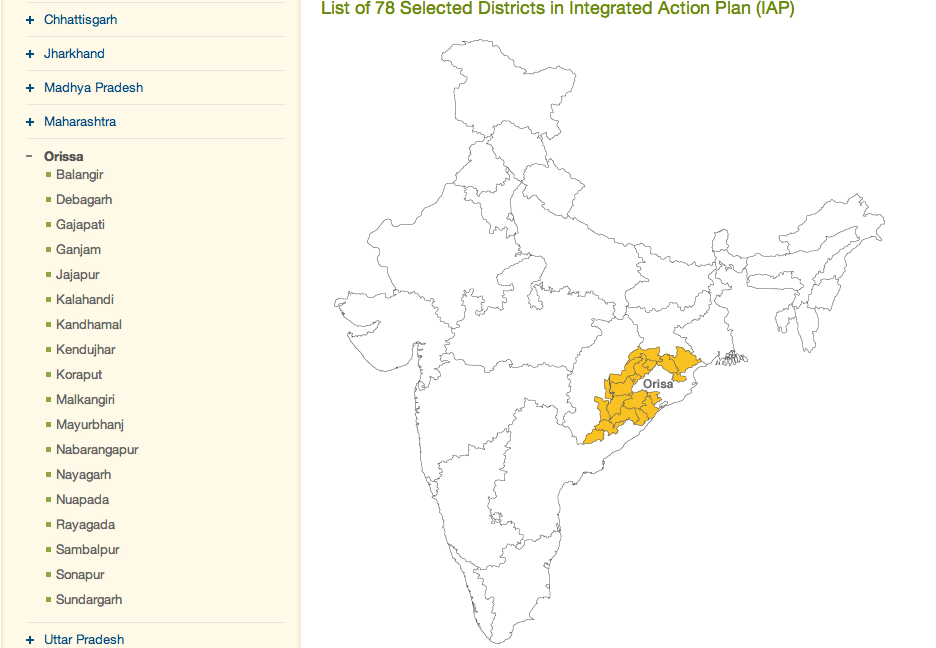
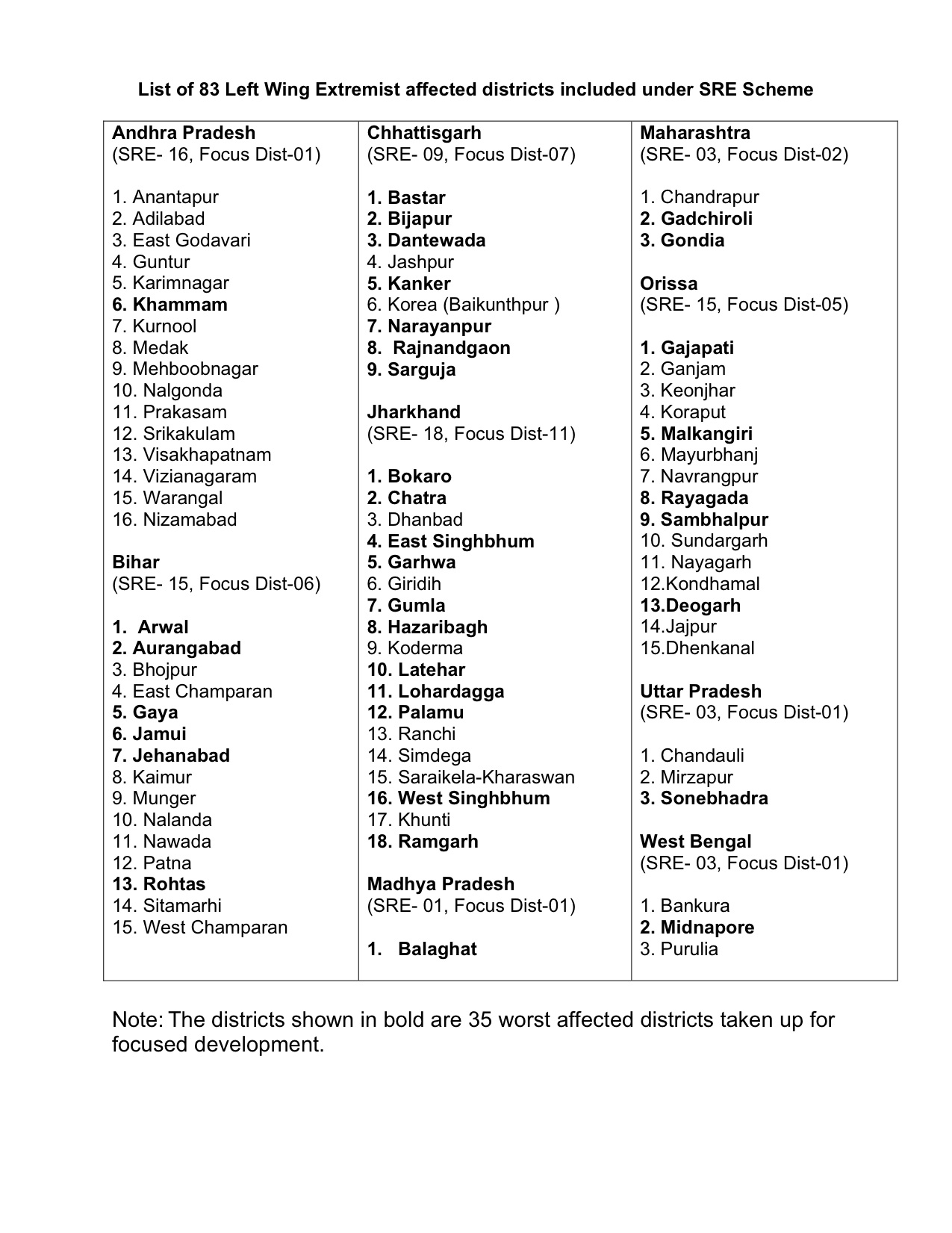 In the 83 SRE districts all the expenses incurred on security in these districts are reimbursed by the MHA. These districts were identified
In the 83 SRE districts all the expenses incurred on security in these districts are reimbursed by the MHA. These districts were identified 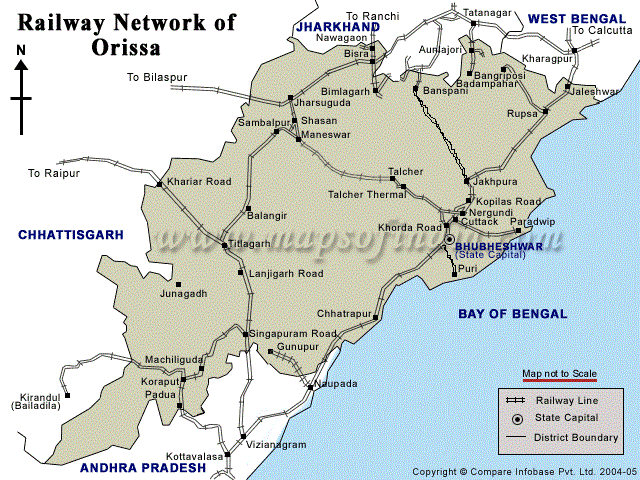
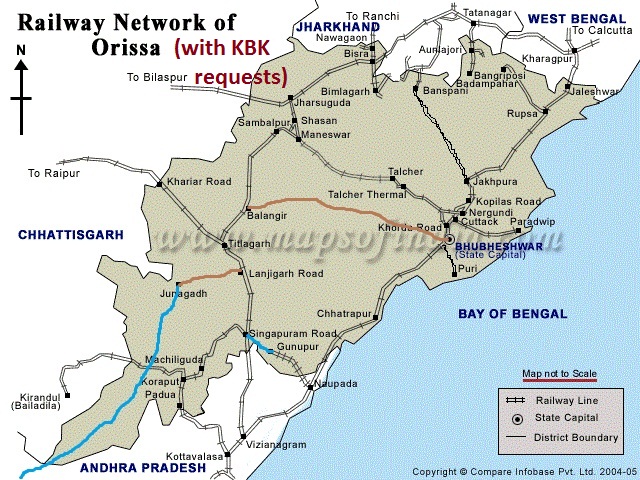
.jpg)
